- Accueil
- Pages cachées
- 20 MARS 2024 NEWS
20 MARS 2024 NEWS
INSTITUT SUPERIEUR D'ANTHROPOLOGIE
INSTITUT OF ANTHROPOLOGY
COURS ONLINE – COURS A DISTANCE
INSCRIPTIONS OUVERTES
REGISTER NOW
GRECE – 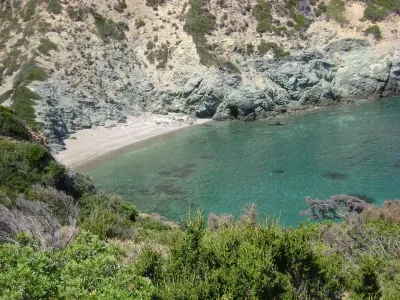 Agios Petros - The small islet of Agios Petros, north of Alonissos, Greece, is believed to be the oldest submerged settlement of the Aegean. Founded around the end of the 7th millennium BC by a community of farmers, fishermen, and seafarers, Agios Petros presents a unique archaeological example of an island settlement. In Agios Petros (Saint Peter) a civilization flourished for about 1,000 years. A few dozen families settled permanently on the islet, which at the time was connected by land to its larger neighbor Kyra Panagia, around 6100 BC. “The fact that the marine settlement of Agios Petros is preserved to this day at the bottom of the Aegean several thousand years after it was founded by the first agricultural groups that arrived in Greece, makes it a special archaeological site,” Nikos Efstratiou, professor of Prehistoric Archeology at the Aristotle University of Thessaloniki (AUTH) says. Efstratiou, who has been heading the archeological research in the area, adds that the site “allows us to investigate a series of important issues concerning the history of the island, the habitation in the Aegean, and the natural environment that the first islanders saw.” Excavations on the islet have revealed stone rectangular and arched buildings, two children’s burials in natural rock cavities, stone piles, and ancient walls. In addition, human-like figurines, inscribed ceramic sherds, and tools made of flint were uncovered, as well as food remains from various animals, birds, fish and oysters.“The islet was not an isolated community but had cultural contacts with other and often more distant areas such as the southern Aegean, Thessaly, the Balkans, and Anatolia. The arrival of agricultural groups from Anatolia to Greece has been proven by archaeological finds,” Efstratiou says. “We learned from the excavations that the inhabitants of Agios Petros were farmers, breeders but also fishermen and hunters. This is evidenced by the remains of animals, birds and fish found in the archaeological layers, on land, and in the sea,” he adds. The prehistoric settlement of Agios Petros was first discovered in the 1960s by the archaeologist Dimitris Theoharis, then the Antiquities Commissioner of Thessaly. Since the 1980s, the head of research has been Efstratiou, who carried out the first marine research in the area, in collaboration with the well-known oceanographer N.C. Flemming and a team of divers from the University of Cambridge. Today the research conducted by the AUTH and the Ephorate of Marine Antiquities is part of a promising five-year program. What archaeologically distinguishes Agios Petros from other projects in Greece is the extensive underwater research, which started in 2021 in the context of an ambitious five-year program (2021-2025).
Agios Petros - The small islet of Agios Petros, north of Alonissos, Greece, is believed to be the oldest submerged settlement of the Aegean. Founded around the end of the 7th millennium BC by a community of farmers, fishermen, and seafarers, Agios Petros presents a unique archaeological example of an island settlement. In Agios Petros (Saint Peter) a civilization flourished for about 1,000 years. A few dozen families settled permanently on the islet, which at the time was connected by land to its larger neighbor Kyra Panagia, around 6100 BC. “The fact that the marine settlement of Agios Petros is preserved to this day at the bottom of the Aegean several thousand years after it was founded by the first agricultural groups that arrived in Greece, makes it a special archaeological site,” Nikos Efstratiou, professor of Prehistoric Archeology at the Aristotle University of Thessaloniki (AUTH) says. Efstratiou, who has been heading the archeological research in the area, adds that the site “allows us to investigate a series of important issues concerning the history of the island, the habitation in the Aegean, and the natural environment that the first islanders saw.” Excavations on the islet have revealed stone rectangular and arched buildings, two children’s burials in natural rock cavities, stone piles, and ancient walls. In addition, human-like figurines, inscribed ceramic sherds, and tools made of flint were uncovered, as well as food remains from various animals, birds, fish and oysters.“The islet was not an isolated community but had cultural contacts with other and often more distant areas such as the southern Aegean, Thessaly, the Balkans, and Anatolia. The arrival of agricultural groups from Anatolia to Greece has been proven by archaeological finds,” Efstratiou says. “We learned from the excavations that the inhabitants of Agios Petros were farmers, breeders but also fishermen and hunters. This is evidenced by the remains of animals, birds and fish found in the archaeological layers, on land, and in the sea,” he adds. The prehistoric settlement of Agios Petros was first discovered in the 1960s by the archaeologist Dimitris Theoharis, then the Antiquities Commissioner of Thessaly. Since the 1980s, the head of research has been Efstratiou, who carried out the first marine research in the area, in collaboration with the well-known oceanographer N.C. Flemming and a team of divers from the University of Cambridge. Today the research conducted by the AUTH and the Ephorate of Marine Antiquities is part of a promising five-year program. What archaeologically distinguishes Agios Petros from other projects in Greece is the extensive underwater research, which started in 2021 in the context of an ambitious five-year program (2021-2025).
The Oldest Submerged Settlement in the Aegean Sea Dates Back 8,000 Years - GreekReporter.com
GUATEMALA – 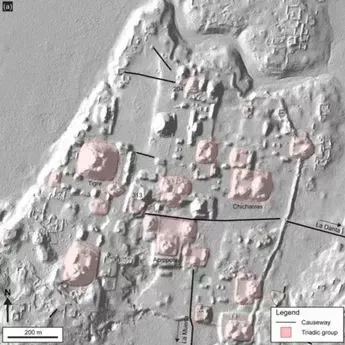
 Mirador-Calakmul Karst An ancient lost Mayan city has been discovered hidden among a rainforest - complete with 1,000 homes and it's own set of pyramids. The settlement was discovered in Guatemala beneath a huge rainforest. It was found using laser technology and covers 650 square miles from Mirador-Calakmul Karst Basin region close to the Mexican border. Archaeologists reckon the city was around more than 2,000 years ago with almost 1000 settlements joined by causeways stretching a thousand miles. The ancient people are believed to have used the pathways to move around. The remains of platforms and pyramids were also found by archaeologists involved in the research. Channels to collect and funnel water were also found guiding the resource to reservoirs and canals. An aerial survey using LiDAR technology discovered the settlement when their reflected light created an image of the landscape. LiDAR (light detection and ranging) allowed researchers to pinpoint indentations and pathways in the land which had been undiscovered for centuries. The analysis has been published in the journal Ancient Mesoamerica. and states: "This study uses airborne Lidar data to demonstrate how complex societies organised their infrastructure to reflect their socio-economic organisation and political power" The detailed probe shed new light on land which has previously been studied for its Mayan ruins. Mesoamerican settlements were thought to be sparsley populated but this research shows this is not true and they were densely packed.
Mirador-Calakmul Karst An ancient lost Mayan city has been discovered hidden among a rainforest - complete with 1,000 homes and it's own set of pyramids. The settlement was discovered in Guatemala beneath a huge rainforest. It was found using laser technology and covers 650 square miles from Mirador-Calakmul Karst Basin region close to the Mexican border. Archaeologists reckon the city was around more than 2,000 years ago with almost 1000 settlements joined by causeways stretching a thousand miles. The ancient people are believed to have used the pathways to move around. The remains of platforms and pyramids were also found by archaeologists involved in the research. Channels to collect and funnel water were also found guiding the resource to reservoirs and canals. An aerial survey using LiDAR technology discovered the settlement when their reflected light created an image of the landscape. LiDAR (light detection and ranging) allowed researchers to pinpoint indentations and pathways in the land which had been undiscovered for centuries. The analysis has been published in the journal Ancient Mesoamerica. and states: "This study uses airborne Lidar data to demonstrate how complex societies organised their infrastructure to reflect their socio-economic organisation and political power" The detailed probe shed new light on land which has previously been studied for its Mayan ruins. Mesoamerican settlements were thought to be sparsley populated but this research shows this is not true and they were densely packed.
ISRAEL –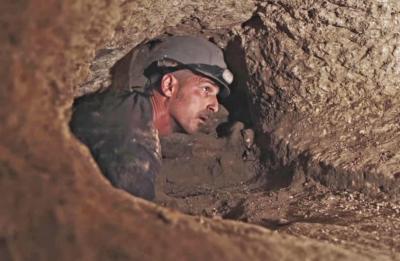 Huqoq - The most-extensive hiding complex discovered to date in the Galilee has been uncovered in an archaeological excavation carried out by the Israel Antiquities Authority (IAA) at the site of Huqoq (Hukkok) – an ancient Jewish village 12.5 kilometers north of Tiberias. The area is mentioned in the Book of Joshua (Joshua 19:34) and has been settled since ancient times. The dig uncovered finds that reveal dramatic episodes in the history of the Jewish people, including the preparation of shelters in preparation for the Revolt of the Jews against the Romans, led by Bar Kochba in 132 to 136 CE. The excavation also revealed that, as part of the preparations for the First Revolt in 66 CE and the Bar Kochba Revolt in 132 CE, the residents of Huqoq converted the water cistern that had been dug during the Second Temple period into a hiding complex. In addition, at the time of danger, they broke one of the walls of the mikveh and dug a tunnel into other cavities. Several tunnels allowed maneuvering in narrow, low spaces underneath the houses. In this underground system, which was the largest and most impressive discovered at the Galilee, there are about eight hiding cavities. The connecting tunnels are dug at 90 degrees make is difficult for the heavily armed Roman soldiers to chase the rebels. The excavation also yielded hundreds of broken clay and glass dishes, an impressive ring for a precious stone (the stone itself was not found), and other fascinating finds. The discovery of the hiding complex can also contribute to a decades-long debate among researchers on whether the Bar Kochba Revolt reached the Galilee or remained within the confines of Judea and central Israel. Based on different findings, Berger and Shivtiel date the inner parts of the hiding complex to the days of the outbreak of the Second Revolt and consider that several of the ancient facilities were first in use during the First Revolt. “It is not certain that the complex was used for hiding and escaping during the Second Revolt, but it does appear to have been prepared for this purpose,” they say. “We hope future excavations will bring us closer to the answer.”
Huqoq - The most-extensive hiding complex discovered to date in the Galilee has been uncovered in an archaeological excavation carried out by the Israel Antiquities Authority (IAA) at the site of Huqoq (Hukkok) – an ancient Jewish village 12.5 kilometers north of Tiberias. The area is mentioned in the Book of Joshua (Joshua 19:34) and has been settled since ancient times. The dig uncovered finds that reveal dramatic episodes in the history of the Jewish people, including the preparation of shelters in preparation for the Revolt of the Jews against the Romans, led by Bar Kochba in 132 to 136 CE. The excavation also revealed that, as part of the preparations for the First Revolt in 66 CE and the Bar Kochba Revolt in 132 CE, the residents of Huqoq converted the water cistern that had been dug during the Second Temple period into a hiding complex. In addition, at the time of danger, they broke one of the walls of the mikveh and dug a tunnel into other cavities. Several tunnels allowed maneuvering in narrow, low spaces underneath the houses. In this underground system, which was the largest and most impressive discovered at the Galilee, there are about eight hiding cavities. The connecting tunnels are dug at 90 degrees make is difficult for the heavily armed Roman soldiers to chase the rebels. The excavation also yielded hundreds of broken clay and glass dishes, an impressive ring for a precious stone (the stone itself was not found), and other fascinating finds. The discovery of the hiding complex can also contribute to a decades-long debate among researchers on whether the Bar Kochba Revolt reached the Galilee or remained within the confines of Judea and central Israel. Based on different findings, Berger and Shivtiel date the inner parts of the hiding complex to the days of the outbreak of the Second Revolt and consider that several of the ancient facilities were first in use during the First Revolt. “It is not certain that the complex was used for hiding and escaping during the Second Revolt, but it does appear to have been prepared for this purpose,” they say. “We hope future excavations will bring us closer to the answer.”
VIDEO = Ancient Jewish hiding place found near Kinneret, in northern Israel - The Jerusalem Post (jpost.com)
ALLEMAGNE – 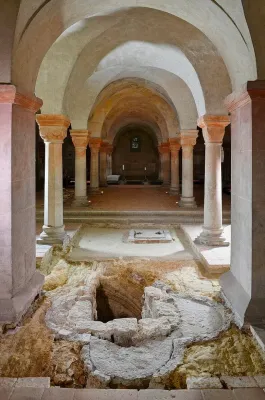 Quedlinburg - Quedlinburg, located in central Germany, was a key town in the Middle Ages, especially during the 10th and 11th centuries when the Ottonian Dynasty ruled the Holy Roman Empire. During current archaeological investigations in the crypt of the collegiate church known as the Stiftsberg, the location of a baptismal font was identified, offering the oldest evidence of a quatrefoil-shaped baptismal font north of the Alps. In the western area of the crypt of the Quedlinburg Collegiate Church, archaeological investigations uncovered a quatrefoil cut into the sandstone in the central axis of the room, about half a metre deep and two metres wide. As a result of joint investigations by archaeology, building research, art history and restoration science using up-to-date documentation and analysis methods, the feature was identified as the location of a baptismal font. The walls of the depression, which was created in the 10th century before the crypt was built, were elaborately lined with pieces of plaster from a previous floor. This bedding held a baptismal font, which has not survived but was presumably made of high-quality material. Later, but also in the 10th century, the base was increased in height for reasons that are still unknown. The fact that this finding is the oldest evidence of a quatrefoil-shaped baptismal font north of the Alps is of great importance in terms of art and architectural history. In addition, its location is also crucial for the reconstruction of the architectural history of the buildings on the Stiftsberg. The room in which the baptismal font originally stood must have been the laity room of a sacred building. There is no evidence that a palatium (prestigious residential building) existed at the site in this period. The baptismal font belonged to a church and also dates from the oldest decades of the Stiftsberg’s medieval history in the Ottonian period, about which little is known so far. It is possible that Duke Henry I of Bavaria (born around 922, died 955), who attempted to kill his brother, Otto the Great in an attack in Quedlinburg at Easter in 941, was baptized at the uncovered location. Mathilde (born 955, died 999), the daughter of Emperor Otto the Great and Empress Adelheid and the first abbess of Quedlinburg Abbey, as well as Adelheid I (born 977; died 1044 in Quedlinburg), the next abbess and daughter of the imperial couple Otto II and the Byzantine Theophanu, could have been baptized here as well.
Quedlinburg - Quedlinburg, located in central Germany, was a key town in the Middle Ages, especially during the 10th and 11th centuries when the Ottonian Dynasty ruled the Holy Roman Empire. During current archaeological investigations in the crypt of the collegiate church known as the Stiftsberg, the location of a baptismal font was identified, offering the oldest evidence of a quatrefoil-shaped baptismal font north of the Alps. In the western area of the crypt of the Quedlinburg Collegiate Church, archaeological investigations uncovered a quatrefoil cut into the sandstone in the central axis of the room, about half a metre deep and two metres wide. As a result of joint investigations by archaeology, building research, art history and restoration science using up-to-date documentation and analysis methods, the feature was identified as the location of a baptismal font. The walls of the depression, which was created in the 10th century before the crypt was built, were elaborately lined with pieces of plaster from a previous floor. This bedding held a baptismal font, which has not survived but was presumably made of high-quality material. Later, but also in the 10th century, the base was increased in height for reasons that are still unknown. The fact that this finding is the oldest evidence of a quatrefoil-shaped baptismal font north of the Alps is of great importance in terms of art and architectural history. In addition, its location is also crucial for the reconstruction of the architectural history of the buildings on the Stiftsberg. The room in which the baptismal font originally stood must have been the laity room of a sacred building. There is no evidence that a palatium (prestigious residential building) existed at the site in this period. The baptismal font belonged to a church and also dates from the oldest decades of the Stiftsberg’s medieval history in the Ottonian period, about which little is known so far. It is possible that Duke Henry I of Bavaria (born around 922, died 955), who attempted to kill his brother, Otto the Great in an attack in Quedlinburg at Easter in 941, was baptized at the uncovered location. Mathilde (born 955, died 999), the daughter of Emperor Otto the Great and Empress Adelheid and the first abbess of Quedlinburg Abbey, as well as Adelheid I (born 977; died 1044 in Quedlinburg), the next abbess and daughter of the imperial couple Otto II and the Byzantine Theophanu, could have been baptized here as well.
Site of Medieval Baptismal Font Discovered in Germany - Medievalists.net
CHINE – Jinan - A total of 168 tombs were recently unearthed in Jinan, the capital city of east China's Shandong Province, according to the archaeology institute of Jinan. This was reported by The Xinhua News Agency. The tombs were discovered at a construction site of a metro depot. Among them, Qing Dynasty (1644-1911) tombs have a predominant presence, followed by those from the Han Dynasty (202 B.C.-220 A.D.).According to the institute, this extensive excavation, which revealed a diverse range of tomb types spanning various historical periods, has enhanced the understanding of burial customs and practices in the region. The cemetery was divided into multiple groups, with each group characterized by its relative concentration, consistent structure and close orientation, said the institute.
168 tombs unearthed in China's Shandong | Ukrainian news (ukranews.com)
CHILI – 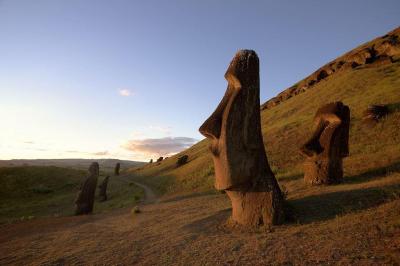 Rapa Nui - For decades, archeologists have debated whether the writing system of Rapa Nui (Easter Island), known as Rongorongo, was invented independently or influenced by Europeans. A new study that uses radiocarbon dating to assess the age of four Rongorongo tablets shows that one of the tablets predates the arrival of Europeans in the 1720s. However, the date only reflects when the wood was felled, and sample size of one isn’t large enough to be entirely certain. Its native people, who are also named the Rapa Nui, first arrived on the island’s shores between 1150 and 1280 CE, and lived in isolation until the arrival of Dutch navigator Jacob Roggeveen in 1722. While Europeans eventually discovered the impressive moai statues for which the Rapa Nui are best known, they also stumbled upon a yet-undeciphered script known as Rongorongo—a three-dimensional writing system that uses pictorial signs known as glyphs. But because this script wasn’t first described until 1864, archaeologist and historians have since pondered an enduring question: Did the Rapa Nui independently invent this language, or where they influenced by Europeans? Now, a new study is attempting to solve this linguistic conundrum by suggesting that, using radiocarbon dating, one of the 27 wooden objects containing Rongorongo inscriptions pre-dates the arrival of Europeans, at around 1493 to 1509. This finding suggests that the Rapa Nui could’ve possibly invented Rongorongo independently—a rare feat throughout human history, and one usually associated with complex states. The other strong piece of evidence for this homegrown language theory is that Rongorongo functions much differently than European languages, which would appear to suggest no discernible outside influence. Lead author Silvia Ferarra, an archeologist and linguist at the University of Bologna, Italy, published her team’s findings in Scientific Reports in early February.
Rapa Nui - For decades, archeologists have debated whether the writing system of Rapa Nui (Easter Island), known as Rongorongo, was invented independently or influenced by Europeans. A new study that uses radiocarbon dating to assess the age of four Rongorongo tablets shows that one of the tablets predates the arrival of Europeans in the 1720s. However, the date only reflects when the wood was felled, and sample size of one isn’t large enough to be entirely certain. Its native people, who are also named the Rapa Nui, first arrived on the island’s shores between 1150 and 1280 CE, and lived in isolation until the arrival of Dutch navigator Jacob Roggeveen in 1722. While Europeans eventually discovered the impressive moai statues for which the Rapa Nui are best known, they also stumbled upon a yet-undeciphered script known as Rongorongo—a three-dimensional writing system that uses pictorial signs known as glyphs. But because this script wasn’t first described until 1864, archaeologist and historians have since pondered an enduring question: Did the Rapa Nui independently invent this language, or where they influenced by Europeans? Now, a new study is attempting to solve this linguistic conundrum by suggesting that, using radiocarbon dating, one of the 27 wooden objects containing Rongorongo inscriptions pre-dates the arrival of Europeans, at around 1493 to 1509. This finding suggests that the Rapa Nui could’ve possibly invented Rongorongo independently—a rare feat throughout human history, and one usually associated with complex states. The other strong piece of evidence for this homegrown language theory is that Rongorongo functions much differently than European languages, which would appear to suggest no discernible outside influence. Lead author Silvia Ferarra, an archeologist and linguist at the University of Bologna, Italy, published her team’s findings in Scientific Reports in early February.
A New Discovery at Easter Island Could Rewrite History as We Know It (prevention.com)
Rep. TCHEQUE – 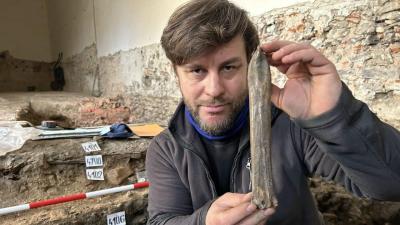 Přerov - Archaeologists from the central Moravian city of Přerov, Czech Republic have announced a unique discovery. While carrying out excavations in the center of the town, they found an ice skate made of animal bone dating back some 1,000 years. The skate was made of animal bone, likely the metacarpal (shin bone) of a horse. Fragments of pottery found around the blade date it to the 10th or 11th century. This find, offers a rare glimpse into the ingenuity and daily life of early medieval societies. Archaeologist Zdeněk Schenk says it was most likely made of horse shin bone: “The object has a specific shape. On one side, it is curved into a tip which has a hole drilled in it and there is another hole at the back. They were used to thread a strap through, which was used to attach the skate to a shoe or to a wooden sledge.” Unlike their modern counterparts used for recreation, these ancient blades served a more practical purpose, explains Schenk. “People back then wouldn’t have used them for leisure skating,” he clarifies. “Instead, they’d shuffle across frozen surfaces with the aid of sticks, or even attach them to sleds for transporting goods over ice.” The bone blade is not the first such object found in Přerov. A similar find was made there in 2009 and more such blades have been unearthed over the years in the wider area of the city. Zdeněk Schenk says this is probably due to its location: “The Upper Square sits on a hill overlooking the Bečva River,” he explains. “In those times, settlements clustered along the river’s branches, making winter travel on the frozen water a necessity.” Schenk emphasizes that Přerov isn’t alone in these discoveries. “Similar ‘ice skates’ made from cattle or horse bones have been found across Europe, particularly in Central and northwestern regions like Scandinavia. Interestingly, many of these finds date to the 10th century and often appear in Viking settlements.”
Přerov - Archaeologists from the central Moravian city of Přerov, Czech Republic have announced a unique discovery. While carrying out excavations in the center of the town, they found an ice skate made of animal bone dating back some 1,000 years. The skate was made of animal bone, likely the metacarpal (shin bone) of a horse. Fragments of pottery found around the blade date it to the 10th or 11th century. This find, offers a rare glimpse into the ingenuity and daily life of early medieval societies. Archaeologist Zdeněk Schenk says it was most likely made of horse shin bone: “The object has a specific shape. On one side, it is curved into a tip which has a hole drilled in it and there is another hole at the back. They were used to thread a strap through, which was used to attach the skate to a shoe or to a wooden sledge.” Unlike their modern counterparts used for recreation, these ancient blades served a more practical purpose, explains Schenk. “People back then wouldn’t have used them for leisure skating,” he clarifies. “Instead, they’d shuffle across frozen surfaces with the aid of sticks, or even attach them to sleds for transporting goods over ice.” The bone blade is not the first such object found in Přerov. A similar find was made there in 2009 and more such blades have been unearthed over the years in the wider area of the city. Zdeněk Schenk says this is probably due to its location: “The Upper Square sits on a hill overlooking the Bečva River,” he explains. “In those times, settlements clustered along the river’s branches, making winter travel on the frozen water a necessity.” Schenk emphasizes that Přerov isn’t alone in these discoveries. “Similar ‘ice skates’ made from cattle or horse bones have been found across Europe, particularly in Central and northwestern regions like Scandinavia. Interestingly, many of these finds date to the 10th century and often appear in Viking settlements.”
https://arkeonews.net/thousand-year-old-bone-skate-discovered-in-czech-republic/
INDE –  Sivan Koodal - An ancient Nataraja idol was found in Sriperumbudur . On Tuesday the Archeology department was digging the ground of the Siva Kulundeswarar. The temple is one of the oldest temples in Tamil Nadu which was constructed over 1000 years ago. The workers while digging the ground found the ancient Nataraja idol along with three Sulam.
Sivan Koodal - An ancient Nataraja idol was found in Sriperumbudur . On Tuesday the Archeology department was digging the ground of the Siva Kulundeswarar. The temple is one of the oldest temples in Tamil Nadu which was constructed over 1000 years ago. The workers while digging the ground found the ancient Nataraja idol along with three Sulam.
1000-year-old Nataraja idol found in Sriperumbudur (dtnext.in
SUEDE 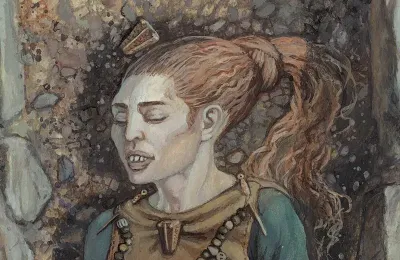
 Gotland - A recent study delves into the discovery of three women from Viking-Age Gotland who underwent skull elongation. This investigation sheds light on the fascinating tradition of body modification prevalent among the Norse and Vikings. The study, authored by Matthias Toplak and Lukas Kerk and published in the journal Current Swedish Archaeology, investigates archaeological findings from Gotland, where half of all documented cases of male teeth filing have been discovered. Alongside the intriguing possibility of Viking tattoos, these practices represent the known forms of body modification taking place in early medieval Scandinavia. Dating back to the latter part of the eleventh century, all three women were interred in different locations across Gotland. Their skull modifications bestowed upon them a distinctive and remarkable appearance, elongating their heads. Further details are discerned in two of the cases: one woman passed away between the ages of 25 and 30, while the other was between 55 and 60 years old. The drawing below, based on excavation reports, is an artistic rendering of how this older woman would have looked when she was buried. Accompanied by ornate jewelry, including four animal-head brooches, a common custom in Gotland, this woman’s grave stands out for its abundance of such adornments. While the religious affiliations of these women remain unknown, Toplak and Kerk propose they were laid to rest within a Christian framework. The authors believe that the practice came to Scandinavia from southeast Europe – it could be found in Bulgaria from the 9th to 11th centuries. “It remains unclear how the custom of skull modification reached Gotland,” they write.”Either the three females from Havor, Ire and Kvie were born in south-eastern Europe, perhaps as children of Gotlandic or East Baltic traders, and their skulls were modified there in the first years of life. Or the modifications were made on Gotland or in the eastern Baltic, respectively, and thus represent a cultural adoption long unknown to the Scandinavian Viking Age. A common background of the three females can be assumed due to the close chronological dating of the three burials, and especially due to the very similar execution of the skull modifications.”
Gotland - A recent study delves into the discovery of three women from Viking-Age Gotland who underwent skull elongation. This investigation sheds light on the fascinating tradition of body modification prevalent among the Norse and Vikings. The study, authored by Matthias Toplak and Lukas Kerk and published in the journal Current Swedish Archaeology, investigates archaeological findings from Gotland, where half of all documented cases of male teeth filing have been discovered. Alongside the intriguing possibility of Viking tattoos, these practices represent the known forms of body modification taking place in early medieval Scandinavia. Dating back to the latter part of the eleventh century, all three women were interred in different locations across Gotland. Their skull modifications bestowed upon them a distinctive and remarkable appearance, elongating their heads. Further details are discerned in two of the cases: one woman passed away between the ages of 25 and 30, while the other was between 55 and 60 years old. The drawing below, based on excavation reports, is an artistic rendering of how this older woman would have looked when she was buried. Accompanied by ornate jewelry, including four animal-head brooches, a common custom in Gotland, this woman’s grave stands out for its abundance of such adornments. While the religious affiliations of these women remain unknown, Toplak and Kerk propose they were laid to rest within a Christian framework. The authors believe that the practice came to Scandinavia from southeast Europe – it could be found in Bulgaria from the 9th to 11th centuries. “It remains unclear how the custom of skull modification reached Gotland,” they write.”Either the three females from Havor, Ire and Kvie were born in south-eastern Europe, perhaps as children of Gotlandic or East Baltic traders, and their skulls were modified there in the first years of life. Or the modifications were made on Gotland or in the eastern Baltic, respectively, and thus represent a cultural adoption long unknown to the Scandinavian Viking Age. A common background of the three females can be assumed due to the close chronological dating of the three burials, and especially due to the very similar execution of the skull modifications.”
Intriguing Skull Modifications Discovered in Viking Women - Medievalists.net



